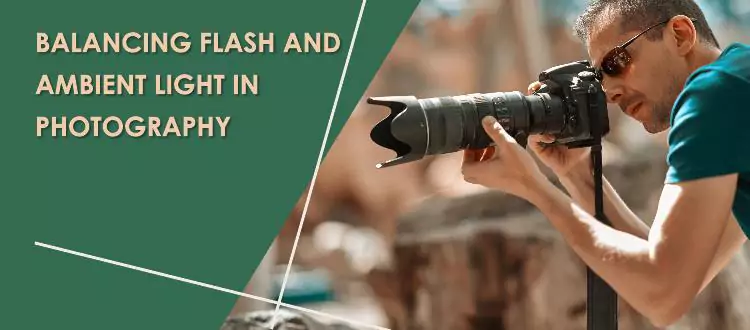Theodore Lowe, Ap #867-859
Sit Rd, Azusa New York
Find us here
The Art of Balancing Flash And Ambient Light in Photography: Master Techniques

Balancing flash and ambient light is crucial for achieving professional-looking photos. Flash can add highlights and fill shadows, while ambient light sets the scene's overall tone. Understanding the interaction between these two light sources allows photographers to create well-lit, dynamic images.
Begin by adjusting camera settings to properly expose the ambient light. Then, introduce flash to fill in shadows or highlight subjects without overpowering the natural light. Practice and experimentation are key to finding the perfect balance. This technique can significantly improve the quality and mood of your photography, making your images stand out.
Understanding Flash Photography
Understanding flash photography is crucial for every photographer. It helps create stunning images. Flash can transform a dull scene into a masterpiece. Mastering flash balance with ambient light is key.
Basics Of Flash
A flash provides additional light during photography. It can freeze motion, highlight details, and add drama. Knowing the basics helps you use it effectively.
-
Manual Mode: You control the flash intensity.
-
TTL Mode: The camera adjusts the flash for you.
-
Fill Flash: Adds light to shadows.
-
Rear Curtain Sync: Fires at the end of the exposure.
Types Of Flashes
There are several types of flashes. Each serves different purposes.
|
Type |
Description |
|---|---|
|
Built-in Flash |
Integrated into the camera. Convenient but limited power. |
|
External Flash |
Attaches to the camera. Offers more power and flexibility. |
|
Off-Camera Flash |
Used away from the camera. Provides creative lighting options. |
Using flash effectively can enhance your photos. Practice different settings and types. This will help you master flash photography.
Exploring Ambient Light
Understanding ambient light is crucial in photography. Ambient light refers to the natural or artificial light in a scene. It sets the tone and mood of your photos. Balancing ambient light with flash can create stunning results.
Natural Light
Natural light comes from the sun. It's the most powerful light source. It changes throughout the day, creating different effects.
-
Morning Light: Soft and warm, great for portraits.
-
Midday Light: Harsh and direct, can create strong shadows.
-
Evening Light: Golden and diffused, perfect for landscapes.
Use natural light to your advantage. Position your subject to capture the best effects. For softer light, shoot during the golden hour.
Artificial Ambient Light
Artificial ambient light comes from man-made sources. These include streetlights, lamps, and neon signs. They add unique colors and effects to your photos.
-
Streetlights: Create warm tones and interesting shadows.
-
Lamps: Provide focused light, highlighting specific areas.
-
Neon Signs: Add vibrant colors and a modern look.
Experiment with artificial light to add creativity to your shots. Mix different sources for unique effects.
Combining flash with ambient light creates balance. It helps control exposure and adds depth to your images.
Techniques For Combining Lights
Combining flash and ambient light in photography creates stunning images. Mastering this balance requires specific techniques. These techniques ensure both lights complement each other. The goal is to achieve a natural-looking photo.
Balancing Exposure
Start with adjusting your camera's exposure settings. Use the ISO, aperture, and shutter speed to balance the light. First, set your camera to manual mode. Begin by exposing for the ambient light. Adjust the shutter speed to control the ambient exposure. Make sure not to exceed your camera's sync speed.
Next, add the flash. Set the flash power to fill in the shadows. Use a light meter to measure the flash output. Ensure the flash exposure matches the ambient light. This balance creates a natural look.
|
Setting |
Control |
|---|---|
|
ISO |
Ambient and flash sensitivity |
|
Aperture |
Depth of field and exposure |
|
Shutter Speed |
Ambient light control |
|
Flash Power |
Flash intensity |
Using Light Modifiers
Light modifiers shape and control the light. They soften or direct the flash. Popular light modifiers include softboxes, umbrellas, and reflectors.
-
Softboxes: They spread the light evenly.
-
Umbrellas: They diffuse the light.
-
Reflectors: They bounce light to fill shadows.
Using these modifiers enhances the quality of light. Softboxes and umbrellas create a soft light. Reflectors fill in shadows with natural light. Combine these tools for a balanced and professional look.
-
Set up your flash with a softbox.
-
Place an umbrella to diffuse the light.
-
Use a reflector to fill in any shadows.
Experiment with different setups. Find what works best for your scene. Balancing flash and ambient light takes practice. Using these techniques will improve your photography skills.
Creative Effects With Light
The art of balancing flash and ambient light can transform your photography. Creative effects with light can enhance your photos. This section explores how to use light to create mood and shadows in your photos.
Creating Mood
Light is a powerful tool in photography. It can set the mood of your photos. You can use flash to highlight subjects while keeping the background dim. This creates a dramatic effect. You can also combine flash and ambient light to make subjects pop. This technique gives a balanced and natural look.
Using different colors of light can add emotion. Warm lights can create a cozy feeling. Cool lights can make a scene feel calm or eerie. You can use gels on your flash to change its color. This adds a creative touch to your photos.
Below is a simple table to guide you on how to create different moods using light:
|
Light Type |
Effect |
|---|---|
|
Warm Light |
Cozy, Inviting |
|
Cool Light |
Calm, Eerie |
|
High Contrast |
Dramatic, Intense |
|
Soft Light |
Gentle, Subtle |
Using Shadows
Shadows add depth and dimension to your photos. You can use flash to control shadows. Position your flash to the side of your subject. This creates interesting shadows and highlights.
Play with the angle of your light. A low angle light can create long shadows. A high angle light can make shadows short and sharp. Shadows can also create patterns. Use objects like leaves or grids to cast unique shadows on your subject.
Here are some tips for using shadows effectively:
-
Use side lighting for dramatic shadows.
-
Experiment with different angles of light.
-
Use objects to create patterned shadows.
-
Combine hard and soft shadows for texture.
Balancing flash and ambient light can create stunning photos. By playing with light and shadows, you can add creativity and depth to your work.
Practical Tips And Tricks
Balancing flash and ambient light can be tricky. Mastering this art requires practice and knowledge. Here are practical tips and tricks to help you achieve the perfect balance in your photography.
Common Mistakes
Many photographers make common mistakes. These errors can ruin a good shot. Being aware of them is crucial.
-
Overexposing the Subject: Adding too much flash can make the subject too bright.
-
Ignoring Ambient Light: Forgetting the natural light can lead to harsh shadows.
-
Wrong Flash Angle: Pointing the flash directly at the subject can cause red-eye.
Pro Tips
Follow these pro tips to master flash and ambient light balance.
-
Use a Diffuser: A diffuser softens the flash light, creating a natural look.
-
Balance Settings: Adjust the flash power and camera settings to match ambient light.
-
Practice Bounce Flash: Bouncing the flash off walls or ceilings spreads light evenly.
-
Use Manual Mode: Manual mode offers more control over both flash and ambient light.
These tips will help you create stunning photos with balanced lighting.
Conclusion
Mastering the balance of flash and ambient light can elevate your photography. Practice and experimentation are key. This technique enhances your images, making them more dynamic and visually appealing. Remember to adjust settings based on your environment.
Related blog posts
10 Best Ways to Share Photography With Your Clients
Capturing the perfect shot is only half the battle; sharing your stunning work with your clients is where the magic truly happens. As a photographer, you know how essential it is to deliver your photos in a way that wows and delights.


